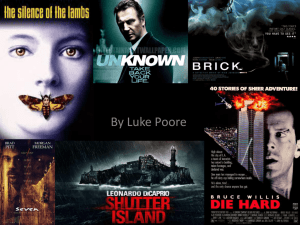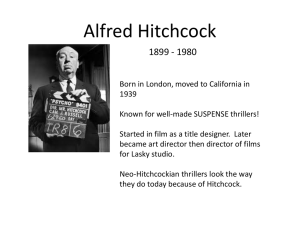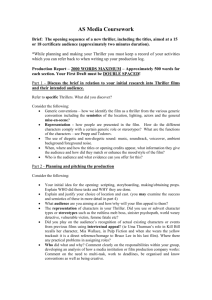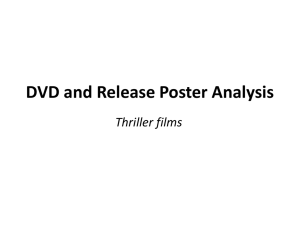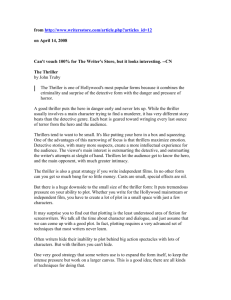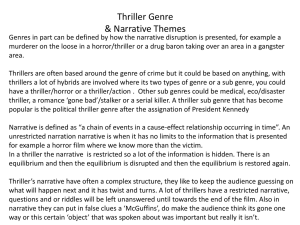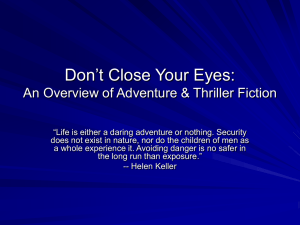Horror is the best movie genre
advertisement
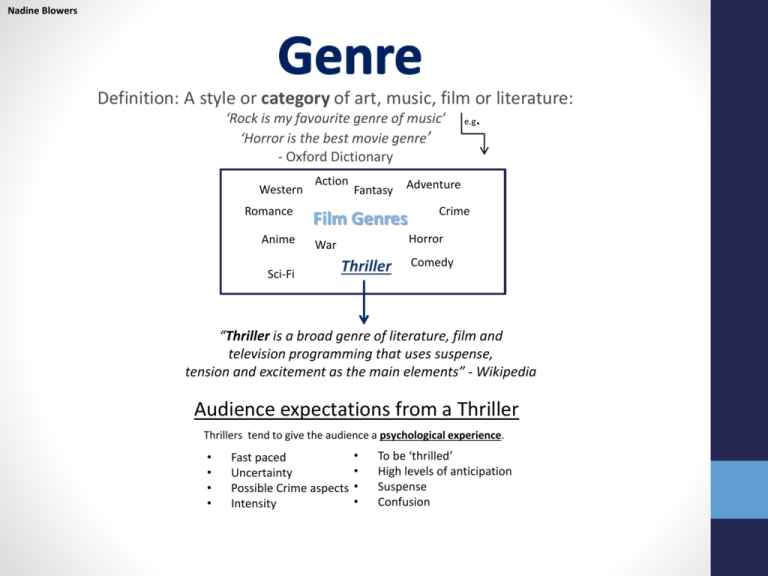
Nadine Blowers Definition: A style or category of art, music, film or literature: ‘Rock is my favourite genre of music’ e.g. ‘Horror is the best movie genre’ - Oxford Dictionary Western Romance Anime Sci-Fi Action Fantasy Adventure Film Genres Crime Horror War Thriller Comedy “Thriller is a broad genre of literature, film and television programming that uses suspense, tension and excitement as the main elements” - Wikipedia Audience expectations from a Thriller Thrillers tend to give the audience a psychological experience. • • • • Fast paced Uncertainty Possible Crime aspects Intensity • • • • To be ‘thrilled’ High levels of anticipation Suspense Confusion Nadine Blowers The first ever Thriller type film that was made was called SAFETY LAST! (1923) It was directed by Fred C. Newmeyer and Sam Taylor, and it was written by Hal Roach, Sam Taylor, H.M. Walker, Jean C. Havez and Harold Lloyd. According to Christian Metz’s development of Genre theory, the first films that are in the beginning of a genre are in the ‘experimental’ stage of development. These films help create rules for the next stages to follow. This is why Safety Last! was important as it created the guidelines for future Thriller films, with the iconic clock scene where Lloyd is hanging from the hands of a clock. This has been replicated in many different ways in today’s thriller films. Safety Last! Is actually a hybrid film, meaning that it combines the codes and conventions of other genres into one film. Another famous Thriller which is debated to be the first actual Thriller film – but definitally the directors first ever Thriller- was directed by the thriller pioneer Alfred Hitchcock – The Lodger (1927) Since then Alfred Hitchcock is well known for directing films such as the world renown Psycho (1960). Psycho fits into the stage of Metz’s theory called the ‘classical’ stage where all the most famous films are made. In the Thriller genre, films such as Silence of The Lambs and Se7en were created. In modern day Thriller films, many of them aren’t just one genre and contain subgenres. Subgenres are when one genre is taken and other aspects of different genres are merged to make a multi genre film. For example, Teen Thrillers, Action Thrillers, Spy Thrillers etc.. Safety First (1923) The Purge (2013) The Lodger (1927) The Girl With The Dragon Tattoo (2011) Psycho (1960) Hanna (2011) The Silence of The Lambs (1991) Se7en (1995) Nadine Blowers Narrative conventions in thriller films indicate that the general plot is seen as a mystery to both the audience and the protagonist; meaning that the film is usually in the perspective of the protagonist. In most thrillers, the antagonist may remain unknown to both the audience and the protagonist which creates suspense that ‘thrills’ the audience and can lead to an exciting climax in the film if the identity is revealed. Following Torodov’s theory of equilibrium, thrillers start off with an equilibrium – meaning that there is normality and balance in the characters lives. Then a disruption to the equilibrium occurs which creates a disequilibrium. An example of this in thriller terms could be a murder etc. A recognition of the disruption is then carried out by the characters which leads to an attempt to repair the damage – which could be the murderer used in the previous example being caught by the police- and then finally a new equilibrium is established. In some Thrillers, new equilibriums could still mean the outcome is bad for example in Se7en, Brad Pitt’s characters wife has died, but it’s the new normal. A lot of thriller films are set in urban locations such as big cities. This can be used because cities are busy and there are lots of strangers which adds to the universal mystery theme of thrillers. Pathetic fallacy is often used in thrillers as the rainy city may indicate to the audience that something bad is going to happen. The lighting in thrillers is usually low-key which is mainly used for creating dramatic scenes and also gives the film a darker narrative. Thriller films always have a serious atmosphere, meaning that the character has to use serious facial expressions and emotions. The make-up and costume is usually quite formal clothes as thrillers often involve characters in uniform; and the make-up is quite natural or used to show stress e.g bags under eyes etc. Nadine Blowers Camerawork : -A lot of panning shots are used in thrillers because they are often slow and reveal a lot of the information about the scene and because of the slow speeds it keeps the audience guessing until the rest is revealed -Close ups are used quite often in thrillers as they reveal emotion and can make the audience understand more about how the character may be feeling. - Extreme close ups are used as it only allows the audience to see a certain object which leaves the bigger picture questionable and creates suspense. -POV shots are another shot which is used in thrillers – usually through the protagonists eyes as the audience are then able to feel part of the action. -High angle shots are used in thrillers to make certain characters look vulnerable (maybe a love interest) -Low angle shots are used in thrillers to make certain characters look bigger and more dominant. -Unconventional angles are very effective in thrillers as they provide a difficult and uncomfortable sensation for the audience. Editing: -Jump cuts and quick shots are used quite frequently in thrillers as they create uncertainty and disorientate the audience -Match on action is used in thrillers to engross the audience and keep them up to date with everything the protagonist is doing so the audience is really seeing the film through the perspective of the protagonist. - Shallow focus can be used to make the audience identify the importance of a person/object Sound: In almost every thriller there is usually an eerie soundtrack (non diegetic) which easily creates suspense and tension. In certain scenes, there might be sharp, piercing sounds (timbre) which is non diegetic and can make the audience feel uneasy. The pace of the music can change and most of the time it changes to meet the pace of the film. This makes the audience involved in the film with more than just their eyes. High pitched noises e.g screams (diegetic sound) also make the audience feel uncomfortable. Silence can also be used in thrillers which contributes to a build up of suspense and uncertainty. Diegetic sounds like dialogue and doors slamming are always used in thrillers which contain sound. Nadine Blowers Slide 1 – Info: http://en.wikipedia.org/wiki/Thriller_(genre) Slide 2 – Info: http://www.tiki-toki.com/timeline/entry/69797/History-of-theThriller-genre/ Pictures: Safety First!, The Lodger, Psycho, The Silence of The Lambs, Se7en, Hanna, The Girl With The Dragon Tattoo, The Purge Slide 3 – Pictures: Question Mark from Clip Art, Diagram of Torodov Theory. Slide 4 -

